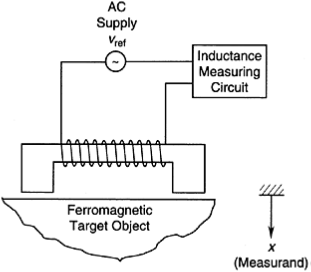SKEDSOFT
Self-induction Transducers
These transducers are based on the principle of self-induction. Unlike mutual-induction transducers, only a single coil is employed.
This coil is activated by an ac supply voltage uref of sufficiently high frequency. The current produces a magnetic flux, which is linked back with the coil. The level of flux linkage (or self-inductance) can be varied by moving a ferromagnetic object within the magnetic field.
This movement changes the reluctance of the flux path and the inductance in the coil. The change in self-inductance, which can be measured using an inductance-measuring circuit (e.g., an inductance bridge; see Chapter 4), represents the measurand (displacement of the object).
Note that self-induction transducers are usually variable-reluctance devices.
A typical self-induction transducer is a self-induction proximity sensor.
This device can be used as a displacement sensor for transverse displacements. For instance, the distance between the sensor tip and ferromagnetic surface of a moving object, such as a beam or shaft, can be measured.
Other applications include those mentioned for mutual-induction proximity sensors. High-speed displacement measurements can give rise to velocity error (rate error) when Schematic diagram of a self-induction proximity sensor.

Variable-inductance displacement sensors (including self-induction transducers) are used.
This effect may be reduced, as in other ac-activated variable-inductance sensors, by increasing the carrier frequency
Permanent-Magnet Transducers
In discussing this third category of variable-inductance transducer, we will present several types of velocity transducers termed tachometers.
A distinctive feature of permanent-magnet transducers is that they have a permanent magnet to generate a uniform and steady magnetic field.
A relative motion between the magnetic field and an electrical conductor induces a voltage, which is proportional to the speed at which the conductor crosses the magnetic field (i.e., the rate of change of flux linkage).
In some designs, a unidirectional magnetic field generated by a dc supply (i.e., an electromagnet) is used in place of a permanent magnet. Nevertheless, they are generally termed permanent-magnet transducers.